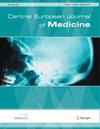Urinary incontinence in adolescent females with cystic fibrosis in Poland
引用次数: 5
Abstract
ObjectivesThere have been many studies regarding urinary incontinence in cystic fibrosis females. However, no data concerning that issue was yet investigated in Poland.MethodsAn anonymous questionnaire was sent by mail to all Polish cystic fibrosis females 16 years of age and older.Results64 patients responded to the questionnaire, 44% reported having urinary incontinence. Median age of onset of incontinence was 14.5 years. There were no differences in age, Body Mass Index (BMI), Forced expiratory volume in 1 second (FEV1), Cystic Fibrosis-Related Diabetes and Percutaneous Endoscopic Gastrostomy between continent and incontinent respondents. Significant correlations between urinary incontinence and number of respiratory exacerbations, sexual activity, and constipation were observed. No relationships between frequency and severity of urinary incontinence and form of chest physiotherapy, BMI and FEV1 were identified. Most respondents declared that urinary incontinence affected their daily life and prevented them from chest physiotherapy.ConclusionsUrinary incontinence should be identified and regarded with high priority in cystic fibrosis; health professionals should be aware that it is their responsibility to actively initiate discussion with patients of that subject in early adolescence.波兰患有囊性纤维化的青春期女性尿失禁
目的对女性囊性纤维化患者尿失禁进行了大量研究。但是,在波兰尚未调查有关这一问题的数据。方法邮寄一份匿名问卷给16岁及以上的波兰囊性纤维化女性。结果64例患者接受问卷调查,44%的患者报告尿失禁。尿失禁的中位发病年龄为14.5岁。尿失禁和尿失禁患者在年龄、体重指数(BMI)、1秒用力呼气量(FEV1)、囊性纤维化相关糖尿病和经皮内镜胃造口术方面均无差异。观察到尿失禁与呼吸系统恶化次数、性活动和便秘之间存在显著相关性。尿失禁的频率和严重程度与胸部物理治疗的形式、BMI和FEV1之间没有关系。大多数受访者表示尿失禁影响了他们的日常生活,使他们无法进行胸部物理治疗。结论囊性纤维化患者应高度重视尿失禁;卫生专业人员应该意识到,他们有责任在青少年早期积极主动地与患者讨论这个问题。
本文章由计算机程序翻译,如有差异,请以英文原文为准。
求助全文
约1分钟内获得全文
求助全文

 求助内容:
求助内容: 应助结果提醒方式:
应助结果提醒方式:


